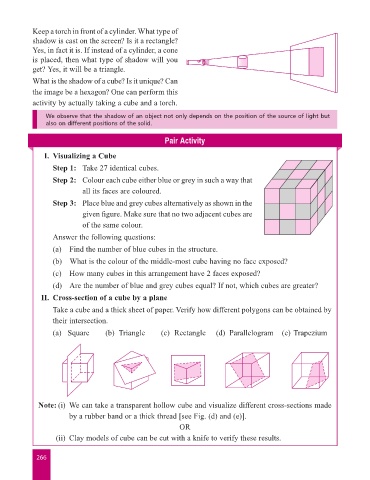Page 274 - Start Up Mathematics_7
P. 274
Keep a torch in front of a cylinder. What type of
shadow is cast on the screen? Is it a rectangle?
Yes, in fact it is. If instead of a cylinder, a cone
is placed, then what type of shadow will you
get? Yes, it will be a triangle.
What is the shadow of a cube? Is it unique? Can
the image be a hexagon? One can perform this
activity by actually taking a cube and a torch.
We observe that the shadow of an object not only depends on the position of the source of light but
also on different positions of the solid.
Pair Activity
I. Visualizing a Cube
Step 1: Take 27 identical cubes.
Step 2: Colour each cube either blue or grey in such a way that
all its faces are coloured.
Step 3: Place blue and grey cubes alternatively as shown in the
given figure. Make sure that no two adjacent cubes are
of the same colour.
Answer the following questions:
(a) Find the number of blue cubes in the structure.
(b) What is the colour of the middle-most cube having no face exposed?
(c) How many cubes in this arrangement have 2 faces exposed?
(d) Are the number of blue and grey cubes equal? If not, which cubes are greater?
II. Cross-section of a cube by a plane
Take a cube and a thick sheet of paper. Verify how different polygons can be obtained by
their intersection.
(a) Square (b) Triangle (c) Rectangle (d) Parallelogram (e) Trapezium
Note: (i) We can take a transparent hollow cube and visualize different cross-sections made
by a rubber band or a thick thread [see Fig. (d) and (e)].
OR
(ii) Clay models of cube can be cut with a knife to verify these results.
266

